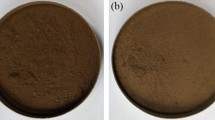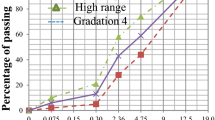Abstract
The study aimed to evaluate how properties of lignin derived from the bio-ethanol industry, affect the chemical and high-temperature characteristics of bitumen–lignin blends. Two types of lignin, fermentation residue lignin (FRL) and isolated lignin (IL) obtained from bio-ethanol residue were analyzed for morphology, thermal stability, elemental composition, and chemical structure. These lignin materials were used to partially replace base bitumen at weight percentages of 5, 10, and 15%. Subsequently, the resulting blends were evaluated for their elemental composition, physical properties (such as softening point, viscosity, and Superpave rutting parameter), and thermal stability. The study revealed that both FRL and IL materials were characterized by spherical particles with rough surfaces. Although the addition of FRL and IL did not notably alter the Hydrogen-to-Carbon ratio of the bitumen, it did elevate the overall content of heteroatoms, including Oxygen, Nitrogen, and Sulphur. This partial replacement of bitumen with FRL and IL led to increased softening point, viscosity, and Superpave rutting parameter of the base bitumen. Crucially, thermal analysis demonstrated that there were no adverse effects on thermal stability within the temperature range pertinent to pavement construction. The observed stiffening of the FRL and IL partially replaced bitumen blends across various tests can be attributed to several factors. These factors encompass aging during blending, Van der Waal's interactions between bitumen and lignin materials due to the rough surface, polar interactions arising from the higher heteroatoms content, and the presence of phenolic functional group, which serve as antioxidant.










Similar content being viewed by others
References
Arafat S, Kumar N, Wasiuddin NM et al (2019) Sustainable lignin to enhance asphalt binder oxidative aging properties and mix properties. J Clean Prod 217:456–468. https://doi.org/10.1016/j.jclepro.2019.01.238
Vliet D Van, Slaghek T, Giezen C, Haaksman I (2016) Lignin as a green alternative for bitumen. In: 6th Eurasphalt and Eurobitume Congress. Prague, Czech Republic
Sivagurunathan P, Raj T, Mohanta CS et al (2021) 2G waste lignin to fuel and high value-added chemicals: approaches, challenges and future outlook for sustainable development. Chemosphere 268:129326. https://doi.org/10.1016/j.chemosphere.2020.129326
Calvo-flores FG, Dobado JA (2010) Lignin as renewable raw material. Chemsuschem 3:1227–1235. https://doi.org/10.1002/cssc.201000157
McCready NS (2007) The utilization of agriculturally derived lignin as an antioxidant in asphalt binder. Iowa State University
Kumar A, Anushree KJ, Bhaskar T (2020) Utilization of lignin: a sustainable and eco-friendly approach. J Energy Inst 93:235–271. https://doi.org/10.1016/j.joei.2019.03.005
Kumar A, Jindal M, Maharana S, Thallada B (2021) Lignin biorefinery: new horizons in catalytic hydrodeoxygenation for the production of chemicals. Energy Fuels 35:16965–16994. https://doi.org/10.1021/acs.energyfuels.1c01651
Norgbey E, Huang J, Hirsch V et al (2020) Unravelling the efficient use of waste lignin as a bitumen modifier for sustainable roads. Constr Build Mater 230:116957. https://doi.org/10.1016/j.conbuildmat.2019.116957
Sundstrom DW, Kiel HE, Daubenspeck TH (1983) Use of byproduct lignins as extenders in asphalt. Ind Eng Chem Prod Res Dev 22:496–500. https://doi.org/10.1021/i300011a022
Wu J, Liu Q, Wang C et al (2021) Investigation of lignin as an alternative extender of bitumen for asphalt pavements. J Clean Prod 283:124663. https://doi.org/10.1016/j.jclepro.2020.124663
Zhang R, Sun S, Wang L et al (2021) Lignin structure defines the properties of asphalt binder as a modifier. Constr Build Mater 310:125156. https://doi.org/10.1016/j.conbuildmat.2021.125156
Lampman P, Vyvyan K, Pavia DL, Kriz GS (2009) Introduction to Spectroscopy, 4 th edn. Brooks/Cole, USA
Wang G, Chen H (2013) Fractionation and characterization of lignin from steam-exploded corn stalk by sequential dissolution in ethanol-water solvent. Sep Purif Technol 120:402–409. https://doi.org/10.1016/j.seppur.2013.10.029
De S, Mishra S, Poonguzhali E et al (2020) Fractionation and characterization of lignin from waste rice straw: biomass surface chemical composition analysis. Int J Biol Macromol 145:795–803. https://doi.org/10.1016/j.ijbiomac.2019.10.068
IS 17079: 2019 (2019) Rubber modified bitumen (RMB): specification. Bureau of Indian Standards
Zheng W, Wang H, Chen Y et al (2021) A review on compatibility between crumb rubber and asphalt binder. Constr Build Mater 297:123820. https://doi.org/10.1016/j.conbuildmat.2021.123820
IS 1205 (1978) Methods for testing tar and bituminous materials: determination of softening point. Bureau of Indian Standards
ASTM 4402M (2015) Standard test method for viscosity determination of asphalt at elevated temperatures using a rotational viscometer. ASTM, Conshohocken, PA
AASHTO T315 (2010) Standard test method for determining the rheological properties of asphalt binder using a dynamic shear rheometer (DSR). American Association of State Highway and Transportation Officials
Brebu M, Vasile C (2010) Thermal degradation of lignin: a review. Cellul Chem Technol 44:353–363
Sembiring S, Situmeang R, Sembiring Z (2019) Synthesis and characterization of asphalt composite precursors using amorphous rice husk silica. Ceramica 65:194–199. https://doi.org/10.1590/0366-69132019653742497
SP-1 (2003) Superpave performance graded asphalt binder specifications and testing. Asphalt Institute
Adwani D, Sreeram A, Pipintakos G et al (2023) Interpreting the effectiveness of antioxidants to increase the resilience of asphalt binders: a global interlaboratory study. Constr Build Mater 366:130231. https://doi.org/10.1016/j.conbuildmat.2022.130231
AASHTO M320 (2010) Standard specification for performance-graded asphalt binder. American Association of State Highway and Transportation Officials
Batista KB, Padilha RPL, Castro TO et al (2018) High-temperature, low-temperature and weathering aging performance of lignin modified asphalt binders. Ind Crops Prod 111:107–116. https://doi.org/10.1016/j.indcrop.2017.10.010
Acknowledgements
The authors would like to express our sincere gratitude to Praj Industries Ltd., Pune, Maharashtra for the supply of lignin containing bio-ethanol residue material.
Author information
Authors and Affiliations
Corresponding author
Ethics declarations
Conflict of interest
The authors have no competing interest to declare.
Additional information
Publisher's Note
Springer Nature remains neutral with regard to jurisdictional claims in published maps and institutional affiliations.
Rights and permissions
Springer Nature or its licensor (e.g. a society or other partner) holds exclusive rights to this article under a publishing agreement with the author(s) or other rightsholder(s); author self-archiving of the accepted manuscript version of this article is solely governed by the terms of such publishing agreement and applicable law.
About this article
Cite this article
Andiyappan, T., Kuna, K.K. Effect of bio-ethanol industry-based lignin properties on the chemical and high-temperature properties of bitumen–lignin blends. Mater Struct 56, 153 (2023). https://doi.org/10.1617/s11527-023-02245-2
Received:
Accepted:
Published:
DOI: https://doi.org/10.1617/s11527-023-02245-2




